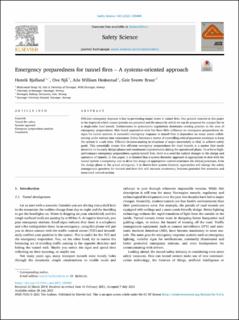| dc.contributor.author | Bjelland, Henrik | |
| dc.contributor.author | Njå, Ove | |
| dc.contributor.author | Heskestad, Atle William | |
| dc.contributor.author | Braut, Geir Sverre | |
| dc.date.accessioned | 2021-08-11T11:55:08Z | |
| dc.date.available | 2021-08-11T11:55:08Z | |
| dc.date.created | 2021-08-02T14:51:27Z | |
| dc.date.issued | 2021-07 | |
| dc.identifier.citation | Bjelland, H., Njå, O., Heskestad, A.W., Braut, G.S. (2021) Emergency preparedness for tunnel fires – A systems-oriented approach. Safety Science, 143, 105408 | en_US |
| dc.identifier.issn | 0925-7535 | |
| dc.identifier.uri | https://hdl.handle.net/11250/2767377 | |
| dc.description.abstract | Efficient emergency response is key to preventing major losses in tunnel fires. Our general concern in this paper is the degree to which tunnel systems are prepared and the means by which we can be prepared for a major fire in a single-tube road tunnel. Conformance to prescriptive regulations dominates existing practice in the area of emergency preparedness. Risk-based approaches exist but have little influence on emergency preparedness designs for tunnel systems. A successful emergency response to tunnel fires is dependent on many actors collaborating under serious time constraints. Safety becomes a matter of controlling critical processes necessary to keep the system in a safe state. Efficient decision-making in situations of major uncertainty is vital, to achieve safety goals. This essentially means that efficient emergency preparedness for road tunnels is a matter that needs attention in the early design phases and continuous improvements during the operational phase. To achieve high-performance emergency preparedness against tunnel fires, there is a need for radical changes to the design and operation of tunnels. In this paper, it is claimed that a system-theoretic approach is appropriate to deal with the tunnel system’s complexity and to drive the design of appropriate control structures for critical processes, from the design phase to the actual emergency. It is shown how system theoretic approaches will change the safety management practices for tunnels and how this will increase consistency between potential fire scenarios and associated control actions. | en_US |
| dc.language.iso | eng | en_US |
| dc.publisher | Elsevier Ltd. | en_US |
| dc.rights | Navngivelse 4.0 Internasjonal | * |
| dc.rights.uri | http://creativecommons.org/licenses/by/4.0/deed.no | * |
| dc.subject | tunneler | en_US |
| dc.subject | veisikkerhet | en_US |
| dc.subject | trafikksikkerhet | en_US |
| dc.subject | tunnelbrann | en_US |
| dc.subject | beredskap | en_US |
| dc.title | Emergency preparedness for tunnel fires – A systems-oriented approach | en_US |
| dc.type | Peer reviewed | en_US |
| dc.type | Journal article | en_US |
| dc.description.version | publishedVersion | en_US |
| dc.rights.holder | © 2021 The Authors. | en_US |
| dc.subject.nsi | VDP::Teknologi: 500 | en_US |
| dc.source.volume | 143 | en_US |
| dc.source.journal | Safety Science | en_US |
| dc.identifier.doi | 10.1016/j.ssci.2021.105408 | |
| dc.identifier.cristin | 1923479 | |
| dc.relation.project | Norges forskningsråd: 280532 | en_US |
| dc.source.articlenumber | 105408 | en_US |
| cristin.ispublished | true | |
| cristin.fulltext | original | |
| cristin.qualitycode | 2 | |

